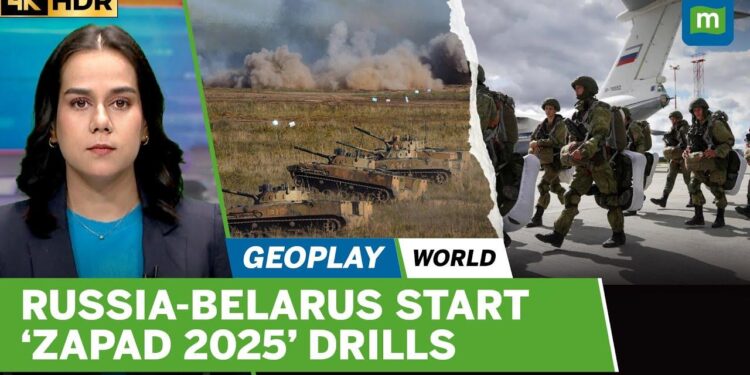Russia and Belarus have launched joint military drills amid escalating tensions following a recent drone incursion into Polish airspace. The exercises come at a time of heightened regional unease, as NATO and neighboring countries express concern over increased military activity near their borders. The coordinated maneuvers underscore the growing complexity of security dynamics in Eastern Europe, raising questions about regional stability and the potential for further confrontations.
Russia Belarus Military Exercises Commence Amid Rising Regional Tensions
In a show of military solidarity and strategic strength, Russia and Belarus have launched extensive joint military drills near their shared borders amid escalating tensions in Eastern Europe. These exercises come shortly after an unexpected drone incursion into Polish airspace, an event that has ignited fears of further regional destabilization. Observers note that the drills include a range of operations from ground force deployments to air defense simulations, signaling a clear message to NATO and neighboring countries about the depth of the military alliance between Moscow and Minsk.
The scope of the maneuvers is impressive, featuring:
- Combined land, air, and cyber warfare training
- Deployment of advanced missile systems
- Coordination between infantry and armored units
- Simulated counter-drone operations
Analysts suggest these activities serve a dual purpose: to prepare forces for potential conflict scenarios and to deter further incursions or provocations. Below is a summary of key military assets involved in the drills:
| Military Asset | Role in Drills | Estimated Deployment |
|---|---|---|
| T-72 Tanks | Armored ground assault | 150 units |
| S-400 Missile Systems | Air defense | 6 batteries |
| Su-35 Fighters | Air superiority and ground attack | 20 aircraft |
| Electronic Warfare Units | Communication disruption | Platoons from both nations |
Analyzing the Strategic Implications of the Poland Drone Incursion
The recent drone incursion over Polish airspace has injected a new layer of complexity into the already volatile Eastern European security landscape. The joint Russia-Belarus military drills signal a clear message of preparedness and deterrence, amplifying existing suspicions over the Kremlin’s regional intentions. Strategically, this event showcases an escalation in hybrid tactics, blending drone technology with traditional ground operations to test NATO’s rapid response capabilities and its commitment to Poland’s defense. The incursion, while brief, highlights vulnerabilities in airspace monitoring and underscores the importance of robust intelligence-sharing among NATO allies.
Implications for regional security include:
- Increased militarization of Belarusian borders, facilitating easier access for Russian assets.
- Heightened alert status among NATO forces, potentially leading to more frequent and larger-scale exercises.
- Pressure on diplomatic channels, limiting opportunities for de-escalation.
| Aspect | Potential Impact |
|---|---|
| Poland’s Air Defense | Enhanced surveillance and integrated drone countermeasures |
| NATO Response Time | Shortened through improved intelligence-sharing protocols |
| Russia-Belarus Military Cooperation | Deepening, with joint drills serving as a blueprint for future operations |
Expert Recommendations for De-escalation and Regional Security Measures
Leading analysts emphasize the urgent need for diplomatic channels to be reopened swiftly to prevent further escalation between Russia, Belarus, and their neighbors. Initiatives such as multilateral talks under the auspices of international organizations like the OSCE (Organization for Security and Co-operation in Europe) are being advocated to build mutual trust. Experts recommend implementing transparency measures around military activities, including real-time reporting of drills and troop movements, to reduce misinformation and miscalculations in the region.
In parallel, regional security frameworks are being reassessed, with a focus on enhancing early warning systems and coordinated responses. Proposed measures include:
- Joint surveillance patrols along sensitive border areas
- Information-sharing protocols between Eastern European nations
- Strengthened cyber defense cooperation to counter hybrid threats
| Measure | Expected Impact | Timeline |
|---|---|---|
| Multilateral Dialogue Platforms | Build trust, ease tensions | Short-term (3-6 months) |
| Joint Border Patrols | Prevent incidents, rapid response | Medium-term (6-12 months) |
| Enhanced Cybersecurity Cooperation | Counter disinformation and attacks | Ongoing |
In Summary
As joint Russia-Belarus military exercises commence amid heightened regional tensions, the situation remains closely monitored by NATO and neighboring countries. The recent drone incursion into Polish airspace has intensified concerns over stability in Eastern Europe, underscoring the fragile security environment. With both Moscow and Minsk signaling a show of strength, international observers are calling for restraint to prevent further escalation in an already volatile geopolitical landscape.
















